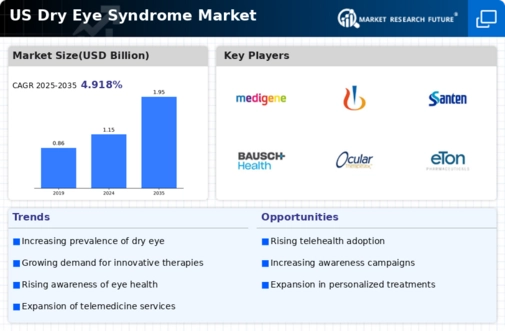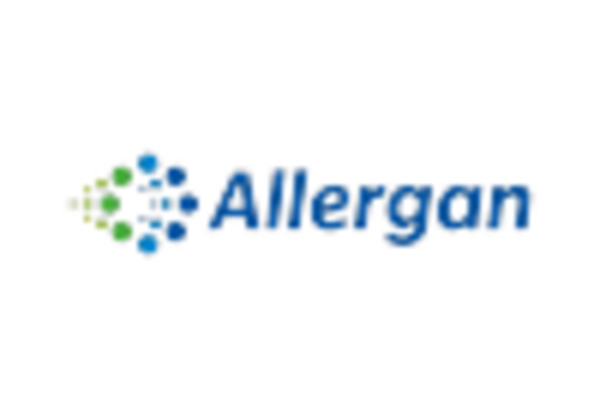Impact of Environmental Factors
Environmental factors play a significant role in the prevalence of dry eye syndrome, thus influencing the market. Factors such as air pollution, climate change, and prolonged exposure to digital screens contribute to the worsening of symptoms. Studies indicate that individuals living in urban areas with high pollution levels are more susceptible to dry eye syndrome. This environmental impact is prompting a greater need for effective treatments and preventive measures, driving growth in the dry eye-syndrome market. Manufacturers are increasingly focusing on developing products that address these environmental challenges, such as protective eyewear and specialized eye drops. As awareness of the link between environmental factors and eye health grows, the market is likely to see an uptick in demand for innovative solutions tailored to mitigate these effects.
Advancements in Pharmaceutical Solutions
Innovations in pharmaceutical treatments are significantly influencing the dry eye-syndrome market. The introduction of novel medications, including anti-inflammatory agents and tear substitutes, has expanded the therapeutic options available to patients. Recent advancements in drug delivery systems, such as sustained-release formulations, enhance the efficacy of treatments, potentially improving patient compliance. The market for prescription eye drops is projected to reach $3 billion by 2026, reflecting the growing investment in research and development. These advancements not only provide better management of symptoms but also address the underlying causes of dry eye syndrome, which may lead to improved patient outcomes. As pharmaceutical companies continue to innovate, the dry eye-syndrome market is likely to experience robust growth driven by these new therapeutic options.
Growing Focus on Eye Health and Wellness
The increasing emphasis on overall eye health and wellness is a notable driver for the dry eye-syndrome market. As consumers become more health-conscious, there is a growing interest in preventive measures and treatments for eye-related conditions. Educational campaigns and initiatives by healthcare organizations are raising awareness about the importance of eye care, which may lead to earlier diagnosis and treatment of dry eye syndrome. This trend is reflected in the rising sales of dietary supplements and lifestyle products aimed at improving eye health. The market for these supplements is projected to grow, indicating a shift towards holistic approaches in managing dry eye syndrome. As consumers prioritize eye wellness, the dry eye-syndrome market is likely to benefit from increased demand for both preventive and therapeutic solutions.
Increasing Prevalence of Dry Eye Syndrome
The rising incidence of dry eye syndrome in the US is a crucial driver for the dry eye-syndrome market. Factors such as aging populations and increased screen time contribute to this trend. According to recent studies, approximately 16 million adults in the US are diagnosed with dry eye syndrome, indicating a substantial market potential. The growing awareness of this condition among healthcare providers and patients is likely to enhance diagnosis rates, further expanding the market. As more individuals seek treatment options, the demand for innovative therapies and products is expected to rise, thereby propelling the growth of the dry eye-syndrome market. This increasing prevalence underscores the necessity for effective management solutions, which may lead to a more competitive landscape among manufacturers and healthcare providers in the coming years.
Rising Demand for Over-the-Counter Products
The increasing consumer preference for over-the-counter (OTC) products is shaping the dry eye-syndrome market. Patients often seek immediate relief from symptoms without the need for prescriptions, leading to a surge in the availability of OTC eye drops and lubricants. The market for these products is expected to grow significantly, with estimates suggesting a value of $1.5 billion by 2025. This trend is driven by heightened awareness of dry eye syndrome and the convenience of accessible treatment options. Retail pharmacies and online platforms are expanding their offerings, making it easier for consumers to find suitable products. As the demand for OTC solutions continues to rise, manufacturers are likely to focus on developing innovative formulations that cater to diverse consumer needs, thereby enhancing their market presence.

















Leave a Comment